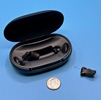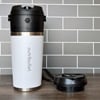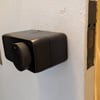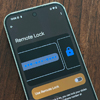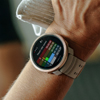We may earn commissions when you buy from links on our site. Why you can trust us.
The Sony CRE-E10 Are the Best OTC Hearing Aids for Music Streaming
Sony's rechargeable bud-styled CRE-E10 ($1,299.99) and its sibling "invisible" CRE-C10 ($999) starkly illustrate the choice faced by first-generation over-the-counter (OTC) hearing aid buyers. The tiny C10 are intended for those who want to improve their everyday, all-day hearing for conversation and TV viewing without anyone realizing they might be wearing a hearing aid. The larger, more visible E10 is designed for hearing-impaired iPhone owners (since audio streaming does not work with Android phones) who want hearing aids that double as Bluetooth-compatible earbuds for music listening and conducting hands-free phone calls.
The differences between these two OTC hearing aid bud styles and purposes present conflicting pros and cons for those trying to choose between them. Long-story short: while ultra-comfy and nearly invisible, the C10 use annoying-to-replace single-use button batteries, and if you want to listen to music from your phone, you either have to put on a pair of headphones over them or replace the C10s with standard Bluetooth earbuds; the Bluetooth-compatible E10s provide louder sound amplification, are powered by a rechargeable battery that supplies a hefty 26 hours of continual hearing use, and serve multiple listening purposes, but they're not as comfortable over several hours of wear, your own voice sounds a bit muffled, and they amplify the sound of chewing, especially crunchy foods.
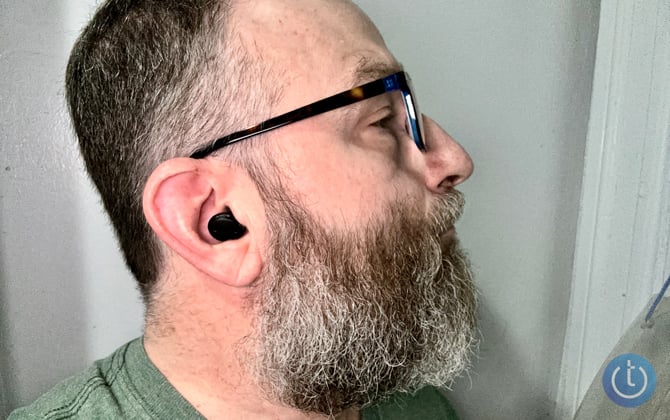
Which would I choose? Since I am an avid music listener and don't need or want to wear hearing aids all day, I lean toward the dual-purpose E10 for occasional wear, especially when I'm out and about. But at $1,300, the E10 is an expensive (arguably over-priced) choice, especially considering the pending HP Hearing PRO, powered by Nuheara (makers of the seemingly similar IQbuds2 Max), which will nearly half the price at $699 and promise more features, such as active noise cancellation, when they launch at the end of the month.
I've been actively wearing and testing the E10 for the last two months, and they are just the latest OTC hearing aids I have tested. Other OTC hearing aids I've reviewed include the aforementioned Sony CRE-C10, the Lexie B2 Powered by Bose, the Jabra Enhance Plus, and the Eargo 5, which technically are not OTC hearing aids since they include audiologist support. In addition, I've been covering the OTC hearing aid category since the category's launch last October. Setting aside price considerations, I find that the Sony CRE-E10 offer the best auditory experience – music and general listening – of all OTC hearing aids with music streaming that are currently on the market.
Ergonomics and set-up
Sony's E10 buds are the size of smaller in-ear buds, with a charging case slightly larger than the Jabra Enhance Plus ($799) OTC hearing aids. Included with the E10 are four sets of "closed" silicone tips – "closed" meaning that the tips aren't perforated or vented, as are the "open" tips included with the Sony CRE-C10, which are designed to allow in ambient sounds – extra small, small (pre-attached), medium, and large.
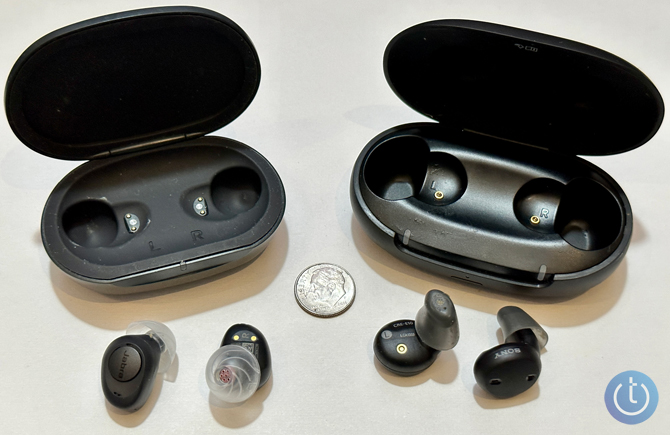
Oddly, these ear tips, which Sony calls "Click Sleeves," are oval rather than round, which, for me, presented challenges when attempting to create the tight ear canal seal the E10 require to minimize feedback squealing endemic with many hearing aids. Each time I inserted the E10, I needed some bud-twisting experimentation before I was able to settle on a satisfactory seal feel.
You do not pair the E10 to your phone via Bluetooth. Like most OTC hearing aids, you pair the E10 to your iPhone via Settings > Accessibility > Hearing Devices. That's because the E10 don't use Bluetooth to transmit music to the buds. Instead, the E10, and all "Bluetooth" iPhone-compatible OTC hearing aids, use Apple's MFI (Made For iPhone) low-energy wireless standard – technically the 2.4 GHz ISM (industrial, scientific, and medical) radio band – and a proprietary Sony audio codec to stream audio, both music, and conversation.
You "self-fit" the E10 via the Sony Hearing Control app hearing test, the same test as for the C10. As with all similar earbud app hearing tests, you are asked whether you can hear a series of different tones at varying volume levels and frequencies for each ear to customize the buds' response to match your specific hearing impairment.
One of the E10's best features is its generous battery life – 26 hours of continuous hearing-only use. The case contains enough juice to fully recharge the E10s twice before it needs recharging, which means you get 78 hours of use on a single buds/case charge, plenty for even a long weekend. Sony's specs note that you get 23 hours of hearing with two hours of audio streaming; if my math is right, that means a full day's 17 hours of hearing mixed with six hours of music streaming.
But no one will want to wear the E10 for six hours at a stretch, much less 17. Unlike Sony's C10, which are not only nearly invisible to the eye but also to the feel while wearing them for lengthy stretches, you feel the E10s in your ears the way you feel any Bluetooth buds. The E10 are not UNcomfortable; they're just not as comfortable as "invisible" type hearing aids such as the C10 and the various Eargo hearing aid models, which you forget you're wearing. My ears felt a sigh of relief when I removed the E10s after several hours.
Auditory performance
Boy, are these E10s LOUD! – far louder than any other OTC buds I've used so far. Inside the Sony Hearing Control app, you can raise the volume to 15, but I found a level of 4-5 provided plenty of sound amplification. I needed to increase the E10 volume higher only while quietly watching TV next to my half-, soon to be fully-asleep, spouse.
Part of the self-fitting nature of the E10 is not only the volume control but the tone level (a bass/treble slide) – both available on the C10 – but mostly and best of all, Directional Hearing, adjustment features that aren't available for the C10. Sony's Auto mode provides a general 360-degree hearing boost. But tapping on one of the four direction segments of the app's hearing circle creates a more specific zone to hear sounds emanating from a specific direction, which is especially helpful in noisy environments when you just want to hear the person sitting right across from you or while watching TV. Other OTC hearing aids often provide some type of directional hearing customization, but none as effective as Sony's with the E10.
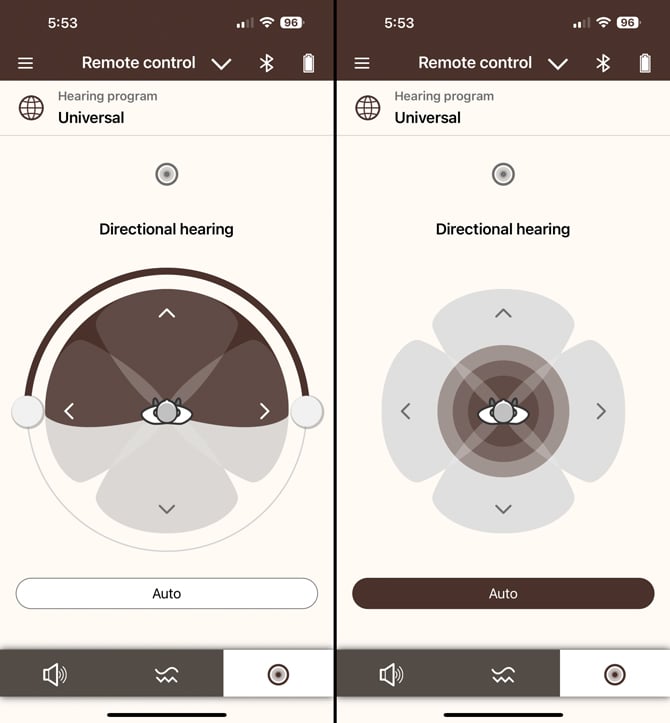
In all volume/directional E10 hearing boosts, sounds come through completely clean and natural. The E10s also solve one of my main issues with the Jabra Enhance Plus ($799)– you can hear your own voice, although you will sound a bit disembodied. I found myself unnecessarily talking louder to overcome this odd sense of hearing a slightly muffled version of my own voice.
One issue shared by all earbud-style OTC hearing aids is that by sealing your canals, you amplify noises inside your head, such as breathing – in a quiet room, my amplified breathing sounded to me like astronaut David Bowman floating around his empty ship in 2001: A Space Odyssey. Amplified chewing sounds muffle most ambient sound or even incoming streaming audio, so I don't recommend chewing gum while wearing the E10s, and over dinner, I started to learn to stop chewing when someone was talking. I also found the E10 not as effective as the C10 at stifling wind noise, but this is an issue only in steady winds of around 7-8-plus MPH.
Satisfying music listening requires some work. First, you need to create a tight bud-to-canal seal to limit fidelity-spoiling sound leakage and ambient noise. Second, to hear streaming sound through the earbuds in iOS, you have to tap the triangle/wave audio source icon in the music or video app and choose "hearing aids." Finally, you need to slide the Sony Hearing Control app's volume lever down to 0 to eliminate the E10 amplified ambient sounds. Once you've gone through this multi-step process, music sounds above average but a smidge underwhelming compared to the robust audiophile results one normally gets from Sony headphones or buds.
In addition, the music streaming connection is fragile – one bud or the other constantly blanked out while I wandered around midtown Manhattan, likely caused by interference from other nearby wireless connections.
Why don't the E10 perform either sonically or connection-wise as well as other standard Bluetooth earbuds? Because while the E10 are "Bluetooth compatible for audio streaming," it's not the same Bluetooth used to transmit music by other wireless earbuds or headphones. Instead, the E10 are using the Apple proprietary MFi hearing aid protocol, and this audio version of MFi includes Sony's own proprietary audio codec, not AAC or Bluetooth's built-in SBC (sub-band coding) audio codec. The specific details of this specification, however, are Apple's confidential information. Sony explains that audio is transmitted from your iPhone to the E10 via a Bluetooth Low Energy link, which is not to be confused with other Made for iPhone (MFi) labels on headphones, which explains the slightly lower fidelity and somewhat less reliable wireless connection. It is likely that other Bluetooth-enabled OTC hearing aids, such as the Jabra Enhance Plus and HP's Hearing Pro, will employ variations of this same MFi-Bluetooth scheme.
What's really challenging for music listening with the E10s is when you suddenly need to hear what's happening around you. The E10s provide no on-bud controls, so you can't single-tap to pause the music and activate the buds' external mics. Instead, when faced with an ambient listening situation, you must pause the music on your iPhone (or an Apple Watch, if you're wearing one), then navigate to the Sony Hearing Control app to raise the E10 volume, a comparatively awkward and annoying process to say the least.
Maintenance
As far as maintenance, the box includes a brush to clear potential earwax from the buds. However, but a Q-tip and rubbing alcohol work just as well as they would for any set of in-ear buds.
The bottom line
Only iPhone users should consider the E10, at least for now, since the E10's music streaming capability is compatible only with iOS.
For occasional wear, the Sony CRE-E10 delivers the most impressive volume and sound directionality of any OTC hearing aid I've tried. That's even with amplified chewing sounds and resisting the impulse to talk louder during conversations to overcome the disembodied sound of my own voice. And the E10 have decent sound when listening to music – the best audio quality currently on the market.
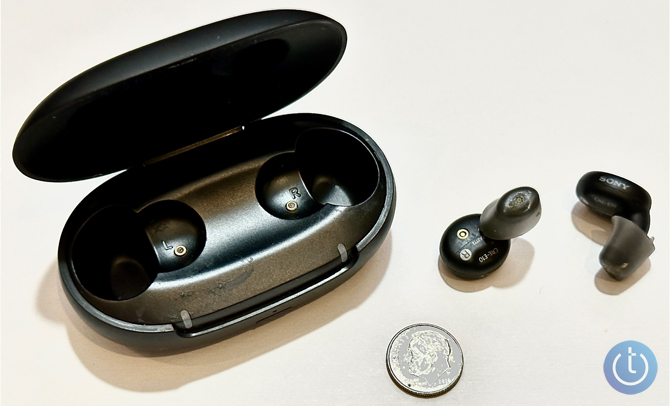
At $1,300, the E10 are way cheaper than any prescription hearing aid, plus you get streaming music and hands-free phone conversations. However, they're expensive when you consider the competition. The ergonomically/functionally similar Jabra Enhance Plus ($799) and the pending HP Hearing PRO earbuds-style OTC hearing aids are almost half the price at $699.
For now, the Sony CRE-E10 are the best OTC hearing aids with Bluetooth music streaming capabilities. However, if you can afford to wait, the HP Hearing PRO ($699) could perform on par with the E10 when they launch later this month for a lot less money.
[Image credit: Stewart Wolpin/Techlicious]
Stewart Wolpin has been writing about consumer electronics for more than 35 years, including news, reviews, analysis and history, and has attended and covered nearly 50 Consumer Electronic Shows and around a dozen IFA shows in Berlin. For the Consumer Technology Association (CTA), he is an elector for and writes the official biographies of the annual CT Hall of Fame inductees, and is the keeper of the industry’s official history.



